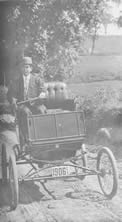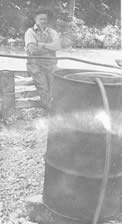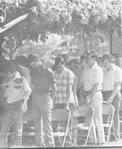 |
Volume IV, No. 3, Spring 1977 |
ORIGINS OF EARLY OZARK SETTLERS
by Russel L. Gerlach*
[*To meet the requests for an article about origins of Ozark settlers, it was natural to turn to our good friend Russet L. Gerlach from Southwest Missouri State University, author of IMMIGRANTS IN THE OZARKS, U. of Mo. Press, 1976, and other works in this field. He wrote this article for BITTERSWEET just before going to England on a Fulbright Scholarship. While there he is doing more research into the Old World origins of Ozark settlers]
The origins of the Ozarks' population are far more complex and varied than most people realize. The Ozarks are more than simply an "Appalachian West." Those who settled the region came from many places and represented many cultures. Sometime glance at the place names represented in the Ozarks of Missouri: River Aux Vasse, Rhineland, Swedeborg, Rosati, Pulaskifield, Swiss, and so on. These names suggest the presence of French, Germans, Swedes, Italians, Poles and Swiss. In fact, descendents of all these groups plus others can be found in the Missouri Ozarks.
Those who settled in the Ozarks came for a variety of reasons. There is of course the oft told story of the pull of the frontier--the legendary ax wielding frontiersmen seeking adventure in the unknown wilderness of the west. No doubt there is some truth in this, but many if not most moved for more practical reasons. Daniel Boone, for example, had to move--someone filed a claim to his land in Kentucky, something he had intended to do but never got around to. Many Settlers in the Appalachians found themselves facing similar circumstances. Many veterans of the War of 1812 came west of the Mississippi River only because that was where the free bounty land for veterans was located. Some left the old areas because they could not conform. A good example of this was the pioneer distiller who would not succumb to the efforts by government to control whiskey making. Following the Whiskey Rebellion in Pennsylvania in 1794, many pioneer distillers packed their stills and other belongings and headed south and west where they could be free of government interference. Some, as we know, made it all the way to the Ozarks where they continue to resent government interference.
A good number, although no one knows how many, were plain criminals, guilty of everything from failure to properly house oxen to murder. A timely departure for the Ozarks saved many a Tom Dooley. Although some continued their lawless activities after arriving in the Ozarks, many became upstanding citizens.
For those not accounted for to now, perhaps restlessness was a factor. The frontiersmen were mobile, and pulling up stakes and moving at a moment's notice was a common practice. The following account tells the migrations of one man.
The ancestor of one of the pioneers of Howell County came from Ireland and settled in South Carolina. His descendants removed to Alabama thence to Tennessee, Illinois and Arkansas successively drifting with the stream courses. The final removal was from Arkansas to Missouri.
Although this pioneer settled in Missouri, others kept moving. Some went to the hills of central Texas where a region known as the Texas Appalachia sprung up--incidentally containing many Missourians by birth. And some continued their westward trek settling in the Rockies and Pacific Coast ranges.
A rather important factor influencing settlement in the Ozarks was the price of land. The wealthier and presumably more successful settlers, such as the slaveholders along the Missouri and Mississippi rivers, did obtain the best land. But they had to pay for its much as $2.50 an acre. In the interior Ozarks, the more rugged land with thin cherty soils sold for as little as 12 1/2 cents an acre. The better land was beyond the means of many of the hill people who came to the Ozarks. The land that was within their means was not very productive. Thus, the wealthy settled on the best land and accumulated even more wealth while the poor continued to eke out a marginal living on the scrabble farms of the interior Ozarks, much as they had done in the Appalachians. These patterns, unfortunately, persist throughout much of the rural Ozarks to this day.
The fact that the Ozarks were similar to their former homes in the Appalachians. no doubt influenced many to settle here. Of equal importance, those who settled early sent word back to the Appalachians with the result that entire family clans frequently made the move to Missouri.
This type of settlement, kin-based migration, accounts for the fact that many Ozark settlements trace back to single counties in the Appalachians.
Chronologically the story begins with the French. (Note: The American Indian is not being overlooked; it just happens that very few survived in the Ozarks of Missouri, although many remain to this day in the Oklahoma portion of the Ozarks.) The French came to the Ozarks at first from Canada where they had been settled for some time along the St. Lawrence River. Prior to 1700 the French were well established on the Illinois side of the Mississippi opposite the Ozarks. Some French hunters, fur traders and miners from the Illinois settlements were actively exploiting resources in the Ozarks by 1700. The resource that made the Ozarks important to the French was lead, and incidentally the Missouri Ozarks still lead the world in lead production.
In 1735 the French established the village of Ste. Genevieve, Missouri's first permanent settlement. Thereafter numerous other settlements were founded by the French, including St. Louis, Cape Girardeau and Potosi. Today only a few locations in the Ozarks retain vestiges of our French past. In Ste. Genevieve the homes of the French remain--possibly the finest collection of colonial French architecture in the United States. Some rural French remain in the vicinity of Old Mines, Missouri where descendents of early miners live in conditions that are best described as bleak. Although the French were responsible for naming many places in Missouri, they are somewhat like the legendary Kilroy. They were here and then gone.
A comment on the Spanish in Missouri might be appropriate here. Control of Louisiana, including Missouri, did pass from the French to the Spanish in 1762 and Missouri remained under Spanish control until 1802. However, the Spanish Crown sent very few Spaniards to Louisiana during this period. In fact, those who came to Missouri during the period of Spanish control were French, Americans and even a few Germans. The Spanish contribution to the culture of the Ozarks is confined to Spanish land grants, a few place names and myths of hidden treasure.
Following the American purchase of Louisiana in 1803, the frontier of settlement began its movement through, or perhaps around the Ozarks. The settlers coming to Missouri after 1803 were mostly native born Americans. In the early years they came from states adjacent to Missouri on the east--- Kentucky, Tennessee and Illinois. Colonel Morgan's colony at New Madrid in 1788 from Kentucky was the first distinctly American settlement. Another early arrival Was Daniel Boone who had come from Kentucky in 1797 and settled along the Missouri River. Boone's son, Nathan, later settled in Greene County where his decaying cabin still stands.
[14]
Generally speaking, the early arriving Americans came from western Tennessee and Kentucky, as well as southern Illinois. As time passed and the frontier pushed west, settlers began coming from the Appalachians proper, and areas to the north and east of the Appalachians. Some went west from Philadelphia and followed the Ohio Valley to Missouri. Others turned south at Philadelphia and followed the Great Valley (the National Road) down through Virginia. In western Virginia is situated one of the few gaps in the Appalachians . a place called Cumberland Gap. Settlers passed through the Gap along a trail blazed by Daniel Boone. Once through the Gap, settlers could either follow the Cumberland or Tennessee rivers on their journey west. Both are tributary to the Ohio, and thus these settlers connected up with those coming down the Ohio from Pittsburgh.
The above account suggests that an individual might depart from say New Jersey and follow a series of routes eventually ending up in the Ozarks. Although some in fact did exactly that, most families going west moved about 100 miles per generation. So a family coming from Pennsylvania might have taken a century or so before arriving in Missouri, and many remained in the Ozarks for only a generation or two before moving on. Thus many Tennesseans who migrated to Missouri were North Carolinians by birth and their ancestors were possibly New Englanders.
For the Ozarks, a head count in 1860 would have indicated that the leading states supplying settlers to Missouri, in order of importance, were Kentucky, Tennessee and Virginia. Many of the Kentuckians and Virginians as well as some of the Tennesseans were wealthy slave owners. They brought with them to Missouri a culture which was very Southern in character. They selected generally the better lands where slaves could be used and commercial crops grown. These areas included the Missouri Valley and the Mississippi Valley, as well as some of the limestone basins in the eastern Ozarks. Regarding the persistence of Southern traits among these people, one writer commented, "Some of the Mississippi and Missouri river portions of the state of Missouri still retain dominant Southern traits and are occasionally referred to by their Political antagonists as Bourbon districts." Several of the counties along and north of the Missouri River are included in the region referred to as "Little Dixie," an area where political and cultural ties have been with the South since the early days of settlement.
The remainder of the Ozarks was dominated by settlers from highland eastern Tennessee, with eastern Kentucky a distant second. Many, if not most, were of Scotch-Irish descent. They were yeoman farmers drawn from the poorest classes. They held few slaves partly because the interior Ozarks would not support a slave economy, but also because slavery was not a part of their cultural baggage.
The settlement of the Ozarks continued and even intensified following the Civil War. The Southern Appalachians continued as a prime source of settlers, but changes were occurring. By 1890 settlers from the prairie states of Ohio, Indiana and Illinois were coming in numbers equal to, and in some cases exceeding those from the Appalachians.
In addition to native born Americans, several hundred thousand Europeans settled in the Ozarks during the nineteenth century. The largest numbers came from German speaking lands. Although a few Germans came early to Missouri, including the so-called Whitewater Dutch who established their settlements in Cape Girardeau County before 1800, most came between 1830 and the Civil War. By 1830 more than a dozen travel books about the Ozarks were in circulation in the German language. These accounts presented a romanticized and exaggerated view of the Ozarks, but nevertheless, they produced results. Countless thousands emigrated from the Old Country directly to Missouri. At one time Missouri was the focus of an effort to create a German speaking state in America.
[15]
[16]
The Hermann settlement in Gasconade County to this day has retained the appearance of a village along the Rhine River.
At the annual Maifest (May Festival) German food, music and conversation abound in a genuinely Old World atmosphere. In Perry County the so-called Saxon Lutherans established several village settlements in 1839. From the small German villages of Altenburg, Wittenberg and Frohna has come the 3,000,000 member Missouri Synod of the Lutheran Church. German settlements in the Ozarks today are distinguished by their large homes, often of brick, and by their religion--largely Lutheran and Catholic. Among the Germans live smaller numbers of Swiss, Belgians, Austrians, Bohemians and Polish.
Following the construction of railroads into the interior Ozarks, and especially in the 1870's and 1880's, a second influx of Europeans occurred. The railroads had very active colonization programs which resulted in the location of more than twenty ethnic settlements in the Ozarks. The Italian community at Rosati brought large scale viticulture to the Ozarks. Other groups included Polish (Pulaskifield), Germans (Freistatt, Lockwood, Billings), Swedes (Verona, Swede Hollow, Swedeborg), Protestant French Waldensians (Monett) and smaller numbers of Hungarians, Yugoslavians, Bohemians and Irish.
Recently a most interesting group has made the Ozarks its home. In the last decade 15 Amish and Mennonite settlements have sprung up in the various parts of the Ozarks. The Amish and Mennonites are of German, Dutch and Austrian background and many continue to use the German language. The more conservative groups have retained a very traditional life style, including simple dress, the use of horse drawn machinery and buggies, and in general a refusal on religious grounds to employ modern technology. Without question, these people add a colorful cultural element to the region.
That in a nutshell is where the people we call Ozarkians have come from. I should add that the story of the settlement of the Ozarks is not yet complete. New pioneers continue to come. From the cities come young people in search of a better life through a return to nature. The Ozarks are dotted with communal settlements bearing names like Dragon Wagon Farm, Valley of Pence Commune, Seven Springs Commune, Aerie Acres and so on. From all over the United States come thousands of retired citizens who choose to spend their final years amidst the beauty and serenity of the Ozark hills.
The map shown here is a summary in geographic form of nearly 300 years of settlement in the Ozarks. As the map clearly shows, the strands of many and varied cultures have been woven into the fabric of the Ozarks. Whether the Ozarks became a mosaic bearing the marks of the various groups, or whether the individuality of the various groups has been erased through the process of assimilation is a question that remains to be answered.
[17]
POPULATION ORIGINS IN RURAL MISSOURI
Shaded areas for GERMAN SETTLED AREAS
Dots for Amish & Mennonites
| G Smaller German Settlements | B Rural Black Settlements |
OTHER GROUPS
| A | Austrian | F | French | P | Polish |
| Ba | Balkan | Gr | Greek | R | Russian |
| Be | Belgian | H | Hungarian | S | Swiss |
| 90 | Bohemian | Ir | Irish | Sw | Swedish |
| Do | Danish | l | Italian | W | Welsh |
| D | Dutch | M | Moravian | Y | Yugoslavian |
OLD STOCK AMERICAN POPULATION
| STATE OF BIRTH IN 1860 | SIGNIFICANT CHANGES AFTER 1860 | ||||
| IL | Illlnois | OH | Ohio | (IL) Illinois | |
| IN | Indiana | TN | Tennessee | (IN) Indiana | |
| KY | Kentucky | VA | Virginia | (IA) Iowa | |
| NC | North Carolina | {OH) Ohio |
[18]
Copyright © 1981 BITTERSWEET, INC.
Next Article | Table of Contents | Other Issues





